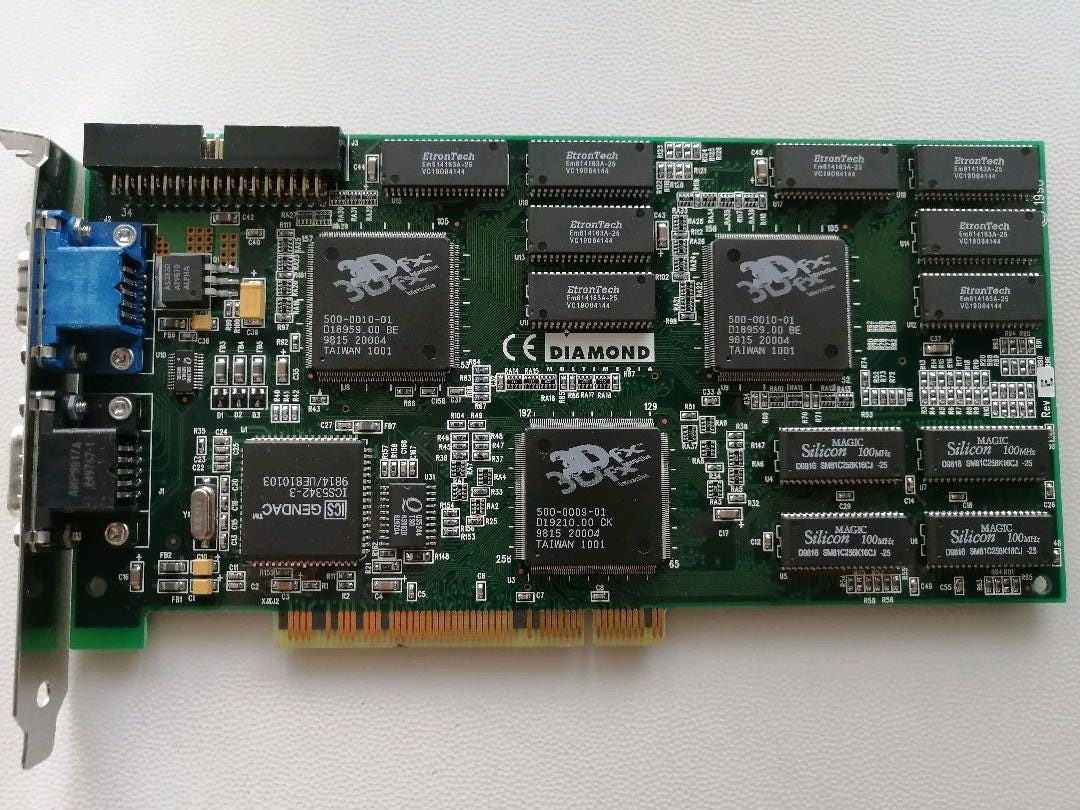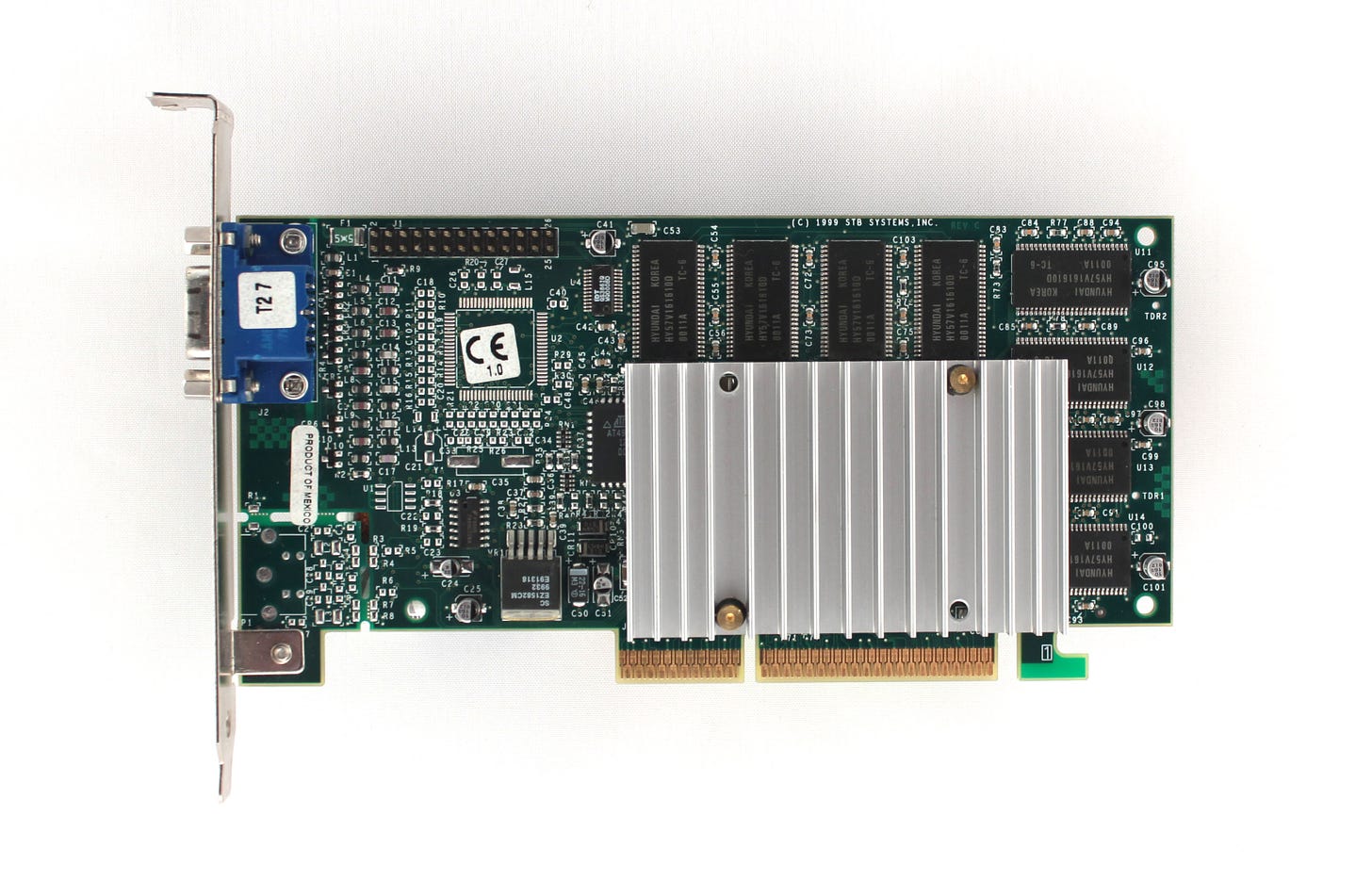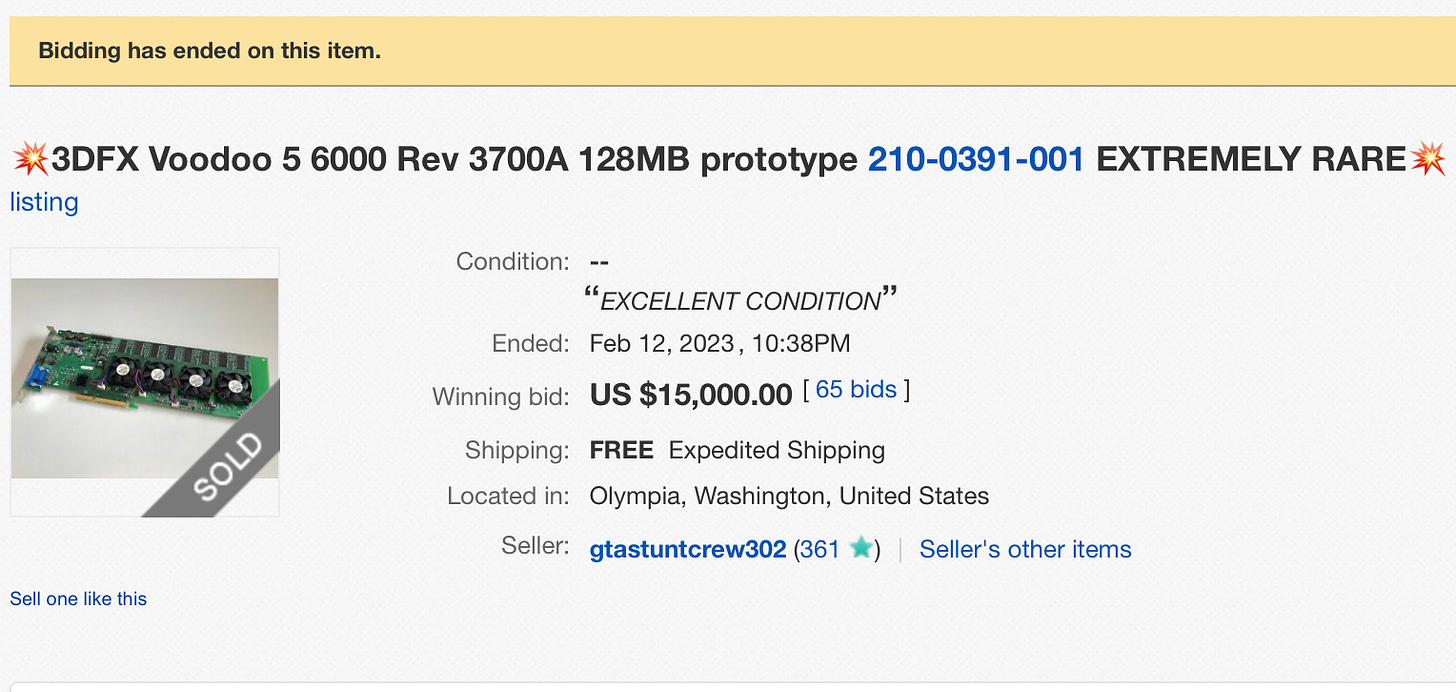In 1988, Silicon Graphics made a series of workstation computers that were based upon two pieces of technology: the MIPS CPU and the IRIS graphics system. The latter included both a hardware 3D graphics accelerator and the IRIS GL API. IRIS GL would later become OpenGL. These machines all ran IRIX (a derivative of System V), and these sold decently well in the workstation market for those who needed serious 3D power. With IRIS’s graphics hardware and API, SGI felt that they may have a product for the PC space. This was the IrisVision card. The first push was with Micro Channel. They added 15-pin VGA with a passthrough input connector. Daughter boards provided framebuffer and z-buffer memory. Once the MCA card was made, work began on a 16 bit ISA slot variant of the card for the compatibles market. While the primary card was slightly different from the MCA version, the daughter boards were the same. SGI didn’t know exactly how to sell this card, and IrisVision was spun off as Pellucid.
Gary Tarolli was born in and grew up in rural New York. He excelled in math and in science, and he went to school initially for math at Rensselaer Polytechnic Institute (RPI) in Troy. He then went to CalTech for VLSI engineering. He worked on VAX at DEC during graduate school, but was recruited by Silicon Graphics where he worked on chip design software for workstations.
Scott Sellers was born in Dallas Texas and at a young age moved to Colorado. He fell in love with computers using BASIC on a TRS-80. He attended Princeton for electrical engineering, VLSI engineering, and computer science. He went to work at SGI after graduation where he spent a lot of time on memory.
Ross Smith grew up in Texas and got his EE in 1983 from University of Texas in Austin. His introduction to computers was with CDC Cyber 70 series timesharing system. He too started out with BASIC, in which he wrote his first program: tic tac toe. His affinity for computers grew as did his interest in games. He started his professional life working for a defense contractor, and worked with AT&T and Sun on various projects. He then went to work for MIPS, and through them ended up at SGI.
Gordon Campbell grew up in Minnesota, and as there wasn’t a market for technology there at the time, he felt he needed to go to Silicon Valley in 1976. He was hired by Intel where he created their corporate marketing department, and ran it for 3 years. He then did their memory marketing for 2 years. He left and started Seeq Technology in 1981. This company achieved quite a bit technologically. For example, their 16K EEPROM memory chip was the first to claim a minimum of 1 million write cycles. It operated at 5 volts and had a 10 millisecond write time. The chip was fitted into a 24-pin ceramic DIP. Rather interestingly, Seeq used an in-house Silicon Oxynitride process. In 1982, Seeq developed and began selling the world’s first Ethernet chipset (10mbps). Campbell left Seeq and created Chips and Technologies (C&T) in 1984 which was an early fabless semiconductor company. C&T’s first product was a four chip EGA chipset announced in September of 1985. These four chips could replicate the function of 19 chips on the IBM EGA board. At COMDEX of ‘85 many companies had introduced EGA compatible boards using C&T’s chipset. By the early 1990s, Campbell had left C&T and became a venture capitalist.
While at SGI, Tarolli, Sellers, and Smith had all had some exposure to SGI’s Reality Engine, and with video games (especially the PlayStation) moving toward 3D graphics, all three saw the potential for consumer 3D acceleration. Importantly, SGI’s solution had been all in-silicon, but Gary had seen that the geometry could be done on the CPU leaving rasterization up to the 3D accelerator. This created the IRIS GL system, but it also showed that things could be done less expensively than had previously been done.
By this point, Tarolli, Sellers, and Smith were all working at Pellucid and selling the Pro Graphics 1024. This was the IrisVision made for the PC compatible market mentioned earlier. The company had many ideas and little focus. Ultimately, they sold to Media Vision in 1993. Media Vision was a rising force in both computer graphics and computer audio. They also got into software publishing, and titles were often bundled with their hardware. The company endured litigation for securities fraud for quite sometime, declared bankruptcy in December of 1994, and became Aureal Semiconductor Inc on the 9th of September in 1995. This company would also go bankrupt and later be acquired by Creative.
After Campbell got his first fund organized, Smith was interviewing for a position at a company with which Campbell was involved and the interview went very badly. It went so badly that Campbell asked Smith what he really wanted to do. The response was that Smith wanted to do PC graphics accelerators with two other guys. Well, why not do that then! A meeting was then setup. Over a fair amount of beer, the four men devised what would become 3dfx. Tarolli, Sellers, Smith, and Campbell founded 3dfx Interactive on the 24th of August in 1994.
When launching C&T, Campbell had had Japanese investors. Those contacts came in handy at 3dfx. Tarolli and Sellers had build a simulator, purely in software, of their 3D accelerator and had it running on a Pentium 90. They then took this to Japan and shopped it to those investors. The first pitch was to Mitsui. It didn’t take much time for them to get plenty of investors on-board. Meanwhile, Smith had designed a GPU expansion card for PCs (initially they’d wanted to do a motherboard and Campbell shot that down repeatedly). The key for this team was to do things cheaply and make the visuals look “good enough” to sell. Their product didn’t need the perfection and precision that SGI aimed to deliver. In fact, they pulled out so much that they sacrificed 2D altogether, and they aimed squarely at 3D knowing that their target consumer would already have some kind of 2D card.
To make efficient use of silicon and memory, 3dfx used two chips. One chip was the buffer, and the other was the T-Rex (texture mapping). Like IRIS GL, the geometry was done on the CPU but with the 3dfx GLide API. Together this chipset featured: perspective-correct texture mapping, bi-linear and advanced filtered textures, multi-level buffering, Gouraud shading, z-buffering, alpha compositing/blending, anti-aliasing, per-pixel fog, smoke and haze effects, texture composition and texture morphing.
The biggest hurdle for the team was memory bandwidth. There were six memory interleaves across the two chips to attempt to overcome this, and the lack of 2D meant that their chips weren’t fighting for any memory.
By the time their designs were sent off to be made into hardware, the company had grown to about 12 people. The 3dfx chips were sent to manufacturing on the 6th of November in 1995. The first chips came back a few days before the Super Bowl, and on the day of the Super Bowl, the team at 3dfx was testing those chips. At first, they thought they’d made some serious mistakes. Everything was running incredibly slowly. They debugged for hours. Smith turned off the debugging tools, and suddenly everything was running flawlessly! Success!
To make their hardware a success, 3dfx approached game developers directly to evangelize their hardware and the GLide API. They actually began doing this before they even had any chips on hand by modifying SGI’s Reality Engine machines and providing them to developers with GLide and demos of several game genres to start working on their own games. Midway and the other arcade companies adopting 3dfx increased the brand’s prestige. Doom launched while the cards were in development, and Quake initially launched with software rendering.
The first chips were put to use in arcade machines; as mentioned they’d adopted 3dfx’s technology early (before hardware was available). So, once the hardware was out in the cabinets, many of these games were huge hits like San Francisco Rush. The price of memory, however, had been falling quickly, the PCI bus became common which was critical for reducing latency from the CPU to the GPU, and the 32 bit transition was effectively complete. That 3dfx had ignored legacy turned out to be a good thing. The home consumer market for 3dfx Voodoo cards then exploded. The first Voodoo card was the Orchid Righteous 3D released on the 7th of October in 1996. It was manufactured on a 500 nm process with 1 million transistors. The clock was at 50 MHz, and it could achieve 50 MP/s or 50 MT/s. The card featured 4MB of EDO RAM also clocked at 50 MHz with a bus width of 128 bits achieving 800 MB/s. By the end of 1997, 3dfx’s Voodoo Gaphics and the GLide API were the dominant 3D accelerators and 3D graphics API for the consumer market.
An engineer at 3dfx built a GLide API renderer for Quake, and 3dfx approached John Carmack and id Software with it. When Carmack saw the result, the port was made. Quake ran beautifully on Voodoo. This turned out to be a massive boost to 3dfx. The launch of Unreal with OpenGL/GLide support served to further cement the brand in the minds of gamers everywhere.
In 1997, 3dfx released the Voodoo Rush. This combined a 3rd party supplied 2D chip with Voodoo Graphics on a single board at the expense of performance. The decreased performance wasn’t just with 3D. The boards typically had poor 2D performance as well. Beyond performance troubles, there were compatibility issues with many popular game titles with early driver releases. All of this meant that the Voodoo Rush was dead on arrival.
When SEGA was designing the successor to the SEGA Saturn, a situation developed with SEGA of Japan working on a design that used the Hitachi SH4 processor with PowerVR graphics, while SEGA of America was working on a design that used a PowerPC 603e and Voodoo Graphics. The Hitachi system was code named White Belt, and the PowerPC system was code named Black Belt.
3dfx Interactive was registered on NASDAQ with the symbol TDFX. Their stock opened for $11.00 ($20.50 in 2023) at IPO on the 25th of June in 1997. 3dfx raised $33 million ($61,511,588.79 in 2023). The company also revealed every detail of the contract with Sega at IPO. SEGA had been keeping development quiet, and SEGA of Japan was apparently quite upset by the release. As a result, SEGA chose to proceed with White Belt, and the Black Belt project was terminated. In September of 1997, 3dfx filed a lawsuit against SEGA and NEC for breach of contract alleging that SEGA had started the deal in bad faith. The matter was settled out of court.
The Voodoo 2 launched in March of 1998. It bumped the available RAM to 12MB, increased the clock to 90MHz, and added a second texture chip (TMU). The Voodoo 2 used 0.35 micron process. The Voodoo 2 also sported Scan-Line Interleave (SLI) where two cards could be connected and each would draw half the lines allowing increased performance.
Toward the end of 1998, the Banshee was released. Here, 3dfx did a combined 2D and 3D design properly. The Banshee design is essentially a Voodoo 2 with only a single TMU. It did have a higher clock at 100 MHz, and the RAM ranged from 8 to 16 MB of SD-RAM or SG-RAM (depending upon board maker and SKU). Some manufacturers pushed the clock to 110 or 120 MHz, and Gigabyte released a Banshee clocked at 130 MHz. The 2D capabilities of this card, however, were top notch. All of the Windows GDI functions were implemented in hardware, and this 128 bit VESA 3.0 compliant 2D core could handle MS-DOS games titles with ease. While it wasn’t quite as fast at 3D as a Voodoo 2, it was matching or exceeding Matrox in the 2D space, and beating most in the 3D space. It’s worth noting that the Voodoo Banshee could render at higher resolutions than the Voodoo 2. By February of 1999, 3dfx had sold over one million Voodoo Banshees.
From the Register on the 27th of January in 1999:
3D graphics leader 3Dfx yesterday reported fourth quarter 1998 revenues of $60.7 million, up 273 per cent on the $22.2 million recorded for the same period last year. However, the increase in revenue did not translate into equally expanded profitability — for Q4 98, 3Dfx made $2.09 million; the Q4 97 figure was a barely-lower $2.07 million. For the full year, the company made $21.7 million, well up on the $1.7 million loss it posted last year. Revenue for fiscal 98 totalled $202.6 million, up from last year’s $44.1 million.
At COMDEX in 1998, 3dfx announced the Voodoo 3. The Voodoo 3 1000 was released in March of 1999 with higher priced SKUs releasing in April and June of that year. The Voodoo 3 was effectively a Banshee but with the second TMU like the Voodoo 2, and a clock of either 125 or 143 MHz. The Voodoo 3 was produced with a 0.25 micron process, and could achieve 125 MP/s and 250 MT/s.
Up to this point, 3dfx had not been in the board business. It had sold chips to OEMs who made boards. This changed with the Voodoo 3. In December of 1998, 3dfx acquired board maker STB for $141 million ($253,199,099.64 in 2023).
From CNN Money on the 14th of December in 1998:
Ballard says the talks with STB were originally strategic, with 3Dfx hoping to launch an original product through STB’s infrastructure. Over the past few weeks, though, the discussions evolved into a takeover.
Once the acquisition is complete, STB’s operations will remain based in Richardson, Texas, with the combined companies’ headquarters at 3Dfx’s office in San Jose.
3dfx was hoping to fully control their brand. At this point, gamers had 3dfx boards and games shipped with the 3dfx logo to show support for those boards. 3dfx didn’t want to share their brand with Diamond or any other manufacturer. Unfortunately, this meant that 3dfx would now be competing with both its former board-making partners and other chip makers, which at least according to Sellers was a major reason for the decline of 3dfx. At the same time, ATI and NVIDIA were on the rise.
At this time, 3dfx had two products targeting the low end of the market, the Velocity 100 and Velocity 200. These were effectively Voodoo 3 2000s with one TMU disabled. This TMU could easily be re-enabled via the Windows Registry:
HKEY_LOCAL_MACHINESystemCurrentControlSetServicesClassDisplay�000GlideThen add:
FX_GLIDE_NUM_TMUSet the value to 2.
The Banshee had given 3dfx an inroad into the OEM PC space, but 3dfx failed to continue down that path with the Voodoo 3. Their development pace also began to slow. ATI’s Radeon and NVIDIA’s RIVA TNT2 were now offering higher performance at roughly the same price. GLide was now no longer so important as Direct3D was able to provide good APIs for 3D games. The Voodoo 4 and Voodoo 5 therefore didn’t do well in the market.
3dfx had been working on a new accelerator called Rampage. Work began in 1998, and this product still had some ways to go. In an attempt to speed up development, 3dfx acquired GigaPixel for $186 million ($323,145,296.17 in 2023) on the 28th of March in 2000. This wouldn’t come to much. Later in 2000, 3dfx’s creditors initiated bankruptcy proceedings against the company. On the 15th of December in 2000, NVIDIA announced that they would acquire 3dfx Interactive’s assets for $70 million ($121,613,821.14 in 2023) and 1 million shares of common stock.
Interestingly, 20 years later, the 3dfx Rampage was tested and found lacking against the NVIDIA GeForce 256 which would have been its competition had the Rampage been released. There were other cards in development at 3dfx that would have been rather competitive, but these never saw the light of day.
This tale brings up many “what ifs.” What if 3dfx had gotten the SEGA Dreamcast contract? Would both companies have been better off? What if 3dfx had continued simply doing chips and not gotten into the board business? Would 3dfx then have brought its products to market more quickly? I think that the secret sauce for 3dfx was really the combination of affordable hardware and the GLide API. With competition in both hardware and API, someone had to loose and 3dfx made a few more mistakes than the competition.
Still, Voodoo Graphics and GLide were the standard in the PC graphics space for a time. 3dfx created an industry that is going strong today, and that industry has affected far more than just gaming. GPUs now power multiple functions in our computers, and they enable AI work as well. For myself, I didn’t own a Voodoo in the 90s. My father was kind enough to bless me with a Matrox Mystique card, and it played such games as I had well enough. I did envy my neighbor who had a Voodoo though: “Ah man! She has a Voodoo 3! That’s sick! You wanna see it run Unreal?” So many games just looked and felt better. As with other articles, I do now have a few Voodoo cards, and revisiting old games with them is quite the experience. Apparently, I am not the only one who feels that way. On the 12th of February in 2023, a Voodoo 5 6000 prototype board sold for $15000 on eBay.
In my mind, this is an absolutely insane amount of money to spend on any bit of home computing gear, but I get it.


















Superb, congratulations